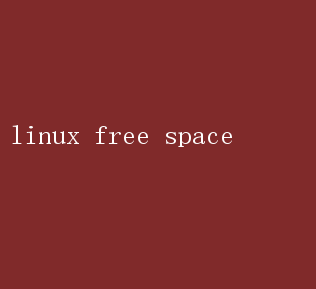Linux系统:轻松查看与管理磁盘空闲空间
linux free space
作者:IIS7AI 时间:2025-01-10 09:15

Linux Free Space Management: Mastering the Art of Optimization In the realm of operating systems, Linux stands tall as a versatile, robust, and highly customizable platform. Whether youre a seasoned sysadmin managing servers in a corporate environment or a passionate developer tinkering with code on your personal machine, understanding and managing Linux free space is crucial for maintaining system performance and reliability. This article delves into the intricacies of Linux free space management, offering practical strategies and tools to help you optimize your systems storage effectively. The Importance of Free Space Management Before diving into the specifics, lets establish why managing free space is so vital. Linux systems, like any other operating system, rely on disk space to store files, applications, and system logs. Over time, as data accumulates, available free space dwindles, leading to potential performance bottlenecks, system crashes, and even data loss in extreme cases. 1.Performance Impact: Insufficient free space can hinder disk I/O operations, causing applications to run slower and the overall system to feel sluggish. 2.System Stability: A disk thats nearly full may prevent critical system updates or the installation of new software, compromising security and functionality. 3.Data Integrity: Running out of space can lead to corrupted files or unexpected system crashes, risking the integrity of your data. 4.Backup Efficiency: Adequate free space is essential for creating reliable backups, ensuring you have a safety net in case of data loss or hardware failure. Understanding Disk Usage Before you can effectively manage free space, its crucial to understand how disk space is being used. Linux provides several command-line tools to help you gain insights into your systems storage status. 1.df Command: The df (diskfree) command displays the amount of disk space available on mounted partitions. bash df -h The`-h` option makes the output human-readable, showing sizes in KB, MB, GB, or TB. 2.du Command: The du (diskusage) command estimates file space usage. Its particularly useful for identifying which directories or files are consuming the most space. bash du -sh /path/to/directory The`-s` option summarizes the total size of each argument,while `-h` provides human-readable output. 3.ncdu Command: ncdu (NCurses Disk Usage) is an interactive disk usage analyzer with a text-based interface. It provides a more intuitive way to navigate and explore disk usage. bash ncdu Strategies for Managing Free Space Now that you know how to assess disk usage, lets explore strategies for managing and optimizing free space. 1.Regular Cleanup: -Delete Temporary Files: Temporary files often accumulate in directories like`/tmp` and`/var/tmp`. Regularly clearing these directories can reclaim significant space. ```bash sudo rm -rf /tmp/ sudo rm -rf /var/tmp/ ``` Note: Be cautious when deleting files in these directories, as some may be in use by running processes. -Remove Unnecessary Packages: Use your Linux distributions package manager to uninstall software you no longer need. ```bash sudo apt-get autoremove For Debian-based systems sudo yum autoremove For Red Hat-based systems ``` -Empty Logs: Logs in `/var/log` can grow large over time. While its important to keep logs for troubleshooting, old logs can be safely deleted or archived. ```bash sudo find /var/log -type f -name.log -mtime +30 -exec rm -f {} ; ``` This command deletes log files older than 30 days. 2.File Compression: - Use compression tools like`gzip,bzip2`,or `xz` to reduce the size of large files or directories. ```bash tar -czvf archive_name.tar.gz /path/to/directory ``` - For ongoing compression of logs, consider using`logrotate` with compression options. 3.Move Data: - If your system disk is running low on space, consider moving large data files, such as videos, music, or backups, to an external drive or network-attached storage(NAS). - Symbolic links can be used to create shortcuts to these moved files, preserving access without占用 primary disk space. 4.Resize Partitions: - If you find that a particular partition is consistently running out of space, you may need to resize it. This often involves using toolslike `gparted` (graphical partition editor) or`fdisk`/`parted` (command-line tools). Resizing partitions can be risky, especially if the partition contains the systems root filesystem; always back up your data before attempting this. 5.Use LVM (Logical Volume Manager): - LVM provides a more flexible way to manage disk space. With LVM, you can create logical volumes that can be resized, snapshotted, and even moved between physical volumes without disrupting service. - Resizing an LVM logical volume typically involves extending or reducing the size of the underlying physical volume and then adjusting the logical volume accordingly. 6.Monitor and Automate: - Set up monitoring toolslike `Nagios,Zabbix`, or`ELKStack`(Elasticsearch, Logstash, Kibana) to keep track of disk usage trends and set alerts when thresholds are approached. - Automate cleanup tasks using cron jobs. For example, you can schedule a cron job to delete old logs or temporary files on a regular basis. Advanced Techniques For those who want to delve deeper, here are some advanced techniques for managing Linux free space. 1.OverlayFS/UnionFS: - These are file system unioning technologies that allow you to combine multiple directories into a single virtual file system. They can be used to overlay read-only data with
- 上一篇:Xshell5:一键新建按钮选项全解析
- 下一篇:Linux中断处理参数详解